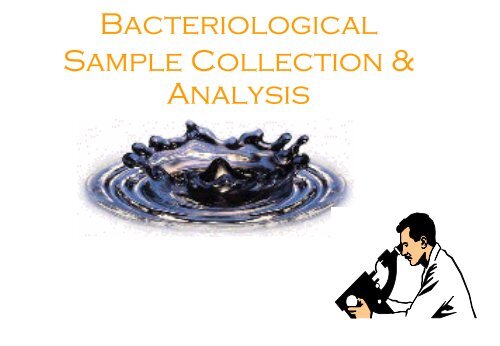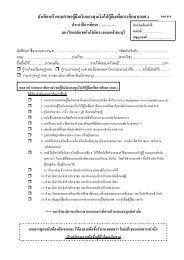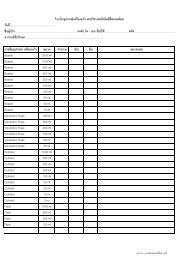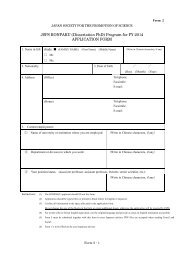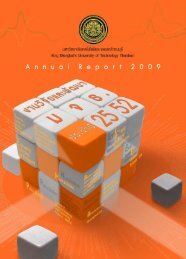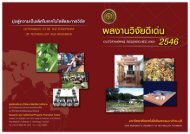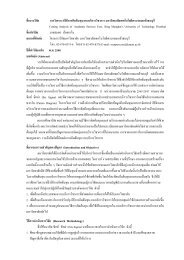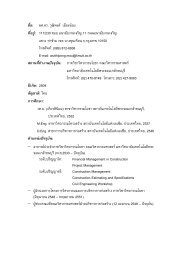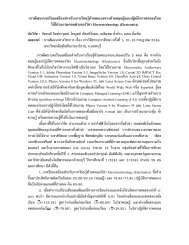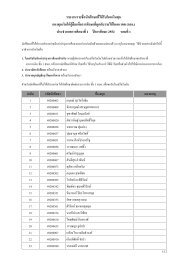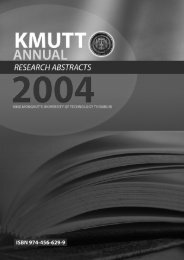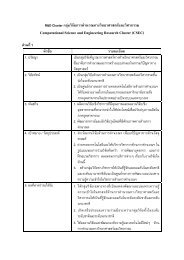Fecal Coliform - kmutt
Fecal Coliform - kmutt
Fecal Coliform - kmutt
Create successful ePaper yourself
Turn your PDF publications into a flip-book with our unique Google optimized e-Paper software.
Bacteriological<br />
Sample Collection &<br />
Analysis
Selection of sample containers: criteria or requirements<br />
• Sterilizable glass or plastic bottles<br />
– Heat resistant<br />
– Permit proper washing<br />
– Uncontaminated until examinations are completed
Types of Bottles<br />
– Plastic or glass bottles<br />
• Suitable size (hold @ least 120 ml)<br />
• Wide-mouthed<br />
• Non toxic<br />
• Able to be sterilized repeatedly
Transportation/storage holding times for<br />
collected samples:<br />
• Optimum time from point of collection to start<br />
of analysis - one hour.<br />
• If the sample can not be processed within one<br />
hour of collection, refrigerate or ice during<br />
transportation
Transportation/storage holding times for<br />
collected samples:<br />
• The recommended time interval is six<br />
hours.<br />
• The maximum time elapsed between<br />
collection and examination should never<br />
exceed 24 hours.
Indicator Organisms<br />
Analytical Techniques<br />
Microbiological Analysis<br />
•Total plate count<br />
•Multiple fermentation tube or Most probable number<br />
•Membrane filter
Bioindicator เปนตัวแทนบงชี ้วาน้ํานั้นมีการปนเป อน<br />
จุลินทรียที่ทําใหเกิดโรค เกณฑในการเลือกจุลินทรียมีดังนี้<br />
1.เปนจุลินทรียที่พบรวมกับจุลินทรียที่กอใหเกิดโรคอยูในน้ํา<br />
และมีจํานวนมากกวา<br />
2.ควรจะเปนชนิดที่เกี่ยวของกับแหลงกําเนิดของจุลินทรียที่<br />
กอใหเกิดโรค<br />
3.มีความทนทานตอกระบวนการบําบัดน้ําเสีย การฆาเชื้อโรค<br />
และสภาวะแวดลอมไดดีกวาจุลินทรียที่กอใหเกิดโรค<br />
4.สามารถทําการวิเคราะหไดเปนประจําบนอาหารเลี้ยงเชื้อที่<br />
งายตอการแยก และสามารถแปรผลที่นาเชื่อถือได
1. Escherichia coli & coliform: G-, non-sporing rod,<br />
facultative, ferment lactose with gas (Total<br />
coliform/Faecal coliform)<br />
2. Faecal Streptococci : G+ cocci, ferment lactose-no gas<br />
3.FC/FS บอกการปนเปอน ถามากกวา 4 มาจากคน ถานอย<br />
กวา 0.6 มาจากสัตว<br />
4. Clostridium perfingens:G+, spore-forming rod,<br />
anaerobic
5. Pseudomonas aeruginosa: aerobic, G- rod, non sporing, non<br />
capsule<br />
6. Staphylococcus aureus : G- cocci, non sporing, non capsule<br />
7. Bacteriophages<br />
<strong>Coliform</strong>/coliphage<br />
87:1 --> raw sewage 4.2:1 --> lagoon eff. 0.15:1--> river water
<strong>Coliform</strong> Group<br />
• All aerobic & facultative anaerobic<br />
gram-neg non-spore-forming rod-shaped<br />
bacteria which ferment lactose with gas<br />
formation within 48 hrs @ 35 o C<br />
• “Total coliform group”<br />
• Indicates possible hazard exists
Sub-groups of <strong>Coliform</strong> Organisms<br />
• Non-fecal<br />
• FECAL
Non-<strong>Fecal</strong> Characteristics<br />
• Example: Enterobacter aerogenes<br />
• Primarily found in soil, grasses, and vegetation<br />
• Survive only in temperatures up to 35 degrees Celsius<br />
• Have longer life span than fecal coliforms<br />
• If presence is greater than fecal coliform it can indicate<br />
an older pollution incident or insufficient chlorination<br />
of the drinking water
<strong>Coliform</strong> Subgroups - <strong>Fecal</strong> <strong>Coliform</strong> (FC)<br />
• Examples:<br />
– Escherichia coli (E. coli) - predominant coliform in<br />
feces of warm-blooded animals; best measure of<br />
drinking water contamination<br />
• Best measure of water supply contamination
<strong>Fecal</strong> Characteristics<br />
• Survive in temperatures up to 44.5 degrees<br />
Celsius<br />
• Short life span<br />
– Presence in greater quantities than non-fecal<br />
organisms can indicate recent pollution
Average bacteria / gram of feces<br />
Animal <strong>Fecal</strong> coliform, 10 6 <strong>Fecal</strong> strep, 10 6 Ratio<br />
Chicken 1.3 3.4 0.4<br />
Cow 0.23 1.3 0.2<br />
Duck 33.0 54.0 0.6<br />
Human 13.0 3.0 4.4<br />
Pig 3.3 84.0 0.04<br />
Sheep 16.0 38.0 0.4<br />
Turkey 0.29 2.8 0.1
Prepare Lab Bench<br />
• Clear the lab bench<br />
• Use Chlorox (bleach) solutions and paper towels to<br />
disinfect<br />
• Assemble all equipment and supplies<br />
• Wash hands
Basic MF Procedure<br />
• Sample volume: 100 ml<br />
• Membrane filter: 47mm diameter, 0.45 micron pore<br />
size<br />
• After filtering water, place membrane filter in treated<br />
petri dish<br />
–Pad<br />
– Media – M-endo
Basic MF Procedure<br />
• Incubate for specified time in the appropriate<br />
incubator<br />
• Interpret results: any coliform indicates a positive<br />
sample.
Media<br />
• Total coliform: M-endo broth<br />
• <strong>Fecal</strong> coliform: M-FC broth<br />
• <strong>Fecal</strong> strep: KF streptococcus agar
Incubation<br />
• Culture plates are incubated upside down so<br />
moisture from condensation does not fall on<br />
developing colonies and stress/kill them<br />
• Total coliform:<br />
– Dry air incubator, 35 o C +/- 0.5C<br />
– 22-24 hours incubation time
Incubation<br />
• <strong>Fecal</strong> coliform:<br />
– Wet bath or aluminum block<br />
incubator, 44.5 o C plus / minus 0.2 o C<br />
– 24 hours incubation time
Incubation<br />
• <strong>Fecal</strong> strep: dry air, 35 0 C +/- 0.5 o C, 48 hrs
Colony Identification (Positive Cultures)<br />
• Characteristics of Positive Samples<br />
– Total coliform: pink to dark red w/ gold/green<br />
metallic sheen<br />
– <strong>Fecal</strong> coliform: various shades of blue<br />
– <strong>Fecal</strong> strep: pink to dark red with no sheen<br />
– How does a negative sample look
Colony Identification<br />
• Confluent growth:<br />
– Continuous growth, colonies run together –<br />
– No distinct colonies<br />
• Too numerous to count (TNTC):<br />
– Colony growth in excess of 200 colonies per 100 ml
Confirmation<br />
• All positive sample results must be<br />
confirmed<br />
• Analyze and confirm to determine the<br />
presence of fecal coliform or E. coli
Confirmation Procedure (<strong>Fecal</strong>)<br />
• Media: EC media – specific for fecal coliform<br />
– In tubes containing inner inverted fermentation tube<br />
• Remove the membrane containing the total coliform<br />
colonies from the petri dish with sterile forceps<br />
• Carefully curl and insert into the tube of EC media<br />
or…...<br />
• Use sterile loop – “streak and swish”
Confirmation Procedure (<strong>Fecal</strong>)<br />
• Incubate in water bath incubator at 44.5 o C +/-<br />
0.2 o C for 24 hrs +/- 2 hrs<br />
• Gas production in the inner tube of the EC<br />
media indicates positive fecal coliform
Confirmation Procedure (E. coli)<br />
• Media: EC media with MUG<br />
– MUG = 4-methylumbelliferyl-beta-D-glucuronide<br />
• Procedure and incubation same as for EC media<br />
– Can use inverted tubes (fecal ID) or no tubes (E. coli)<br />
• Positive for E. coli is shown by fluorescence under UV<br />
lamp<br />
– More on MUG later
Confirmation Procedure (E. coli)<br />
• Media: nutrient agar with MUG<br />
– In a petri dish<br />
• Transfer positive membrane filter to nutrient agar plate with<br />
sterile forceps<br />
• Incubate in dry air incubator at 35 o C for 4 hours<br />
• If fluorescence occurs under ultraviolet (UV) lamp, E. coli<br />
is present
MPN Technique<br />
1. Presumptive test : lactose or lauryl tryptose broth 24<br />
hr,35 C ---> produced gas<br />
2. Confirmed test : brilliant green lactose bile broth<br />
48 hr,35 C ---> produced gas<br />
3.Completed test : Endo or EMB plates, 24 hr 35 C ,<br />
gram stain ----> G-, rod no spore
Principles of Enumerating Bacterial Population Densities Using the Multiple<br />
Fermentation Tube Technique - II<br />
• Within each dilution, an equal amount of sample is placed in 5 separate<br />
fermentation tubes.<br />
10 mL<br />
Each<br />
Tube<br />
Sample Fermentation Tubes, #1- #5<br />
• The process is repeated for three successive serial dilutions. 15 tubes total.
Principles of Enumerating Bacterial Population Densities Using the Multiple<br />
Fermentation Tube Technique - IV<br />
• As an example, consider the following possibility:<br />
Set #1, Sample Set #2, 1:10 Dilution Set #3, 1:100 Dilution<br />
4 Positive 1 Positive 2 Positive<br />
• For this combination, the Poisson Distribution yields the following results:<br />
– The most probable number (MPN) of bacteria is: 21 bacteria per 100 mL<br />
– There is a 95% probability that the correct number is within the range: 9 - 55 bacteria<br />
per 100 mL
ตารางที่ 9 เปรียบเทียบขอดี และขอเสียของการวิเคราะห coliform bacteria<br />
โดยวิธี MPN และ membrane filtration (Hutton, 1983 in Gray, 1989)<br />
Multiple tube MPN<br />
Costs<br />
Large quantities of culture media and glassware and large autoclave<br />
Capital costs fairly high<br />
Accuracy<br />
Statistically based estimate Possibly large errors especially at low levels<br />
Field use<br />
Needs static base<br />
Suspended matter<br />
May be used for turbid samples<br />
Convenience<br />
Large amount of material to be prepared prior to analysis and disposed of after<br />
incubation<br />
Incubation times<br />
Up to 48 h or 72 h
Positive Test for Total <strong>Coliform</strong> Organisms - Presumptive Test<br />
• Initially sterile<br />
• Lactose broth containing Lauryl Sulfate<br />
{(C 12 H 25 O) 2 SO 2 }<br />
• Inverted tube to capture CO 2 produced as part of<br />
fermentation<br />
• Inoculated with water sample<br />
• Incubate 48 hours at 37°C (body temp.)<br />
• If gas appears in inverted tube, test is positive<br />
• Thus, an organism was introduced that ferments lactose<br />
in the presence of lauryl sulfate at 37°C
Use of Confirmation and Presumptive Test for Total <strong>Coliform</strong><br />
• Each time a positive test is recorded, the population density of organisms<br />
reported increases significantly.<br />
• To make sure a positive test is indeed positive, organisms from a positive test<br />
are transferred to a different medium.<br />
• Although the medium is different, it relies on the same principle, fermentation<br />
of lactose in the presence of bile salts.
Positive Test for Total <strong>Coliform</strong> Organisms - Confirmation Test<br />
• Initially sterile<br />
• Brilliant green bile broth, lactose and bile salts.<br />
• Inverted tube to capture CO 2 produced as part of<br />
fermentation<br />
• Inoculated with loop from presumptive test.<br />
• Incubate 24 hours at 37°C (body temp.)<br />
• If gas appears in inverted tube, test is positive<br />
• Thus, an organism was introduced that ferments lactose<br />
in the presence of bile salts at 37°C
Positive Test for <strong>Fecal</strong> <strong>Coliform</strong> Organisms<br />
• Initially sterile<br />
• Lactose broth containing bile salts<br />
• Inverted tube to capture CO 2 produced as part of<br />
fermentation<br />
• Inoculated with water sample<br />
• Incubate 48 hours at 44.5°C (112.1°F)<br />
• If gas appears in inverted tube, test is positive<br />
• Thus, an organism was introduced that ferments lactose<br />
in the presence of bile salts at 44.5°C
Positive Test for <strong>Fecal</strong> Streptococcus Organisms - Presumptive Test<br />
• Initially sterile<br />
• Glucose broth containing sodium azide (NaN 3 ).<br />
Sodium azide is highly toxic, but serves to select for<br />
streptococcus group.<br />
• Inoculated with water sample<br />
• Incubate 48 hours at 35°C (95°F)<br />
• If contents of test tube become turbid, test is positive.<br />
• Thus, an organism is present that is likely to be part of<br />
the streptococcus group associated with fecal material.
Positive Test for <strong>Fecal</strong> Streptococcus Organisms - Confirmation Test<br />
• Initially sterile<br />
• Pfizer selective enterococcus (PSE) agar, complex<br />
organic media (bacterial candy), bile salts, and sodium<br />
azide.<br />
• Streak with contents of positive presumptive test.<br />
• Incubate 24 hours at 35°C (95°F)<br />
• If brownish-black colonies with brown halos appear<br />
the presumptive test was indeed positive.<br />
• Thus, it is confirmed that an organism is present that is likely to be part of the<br />
streptococcus group associated with fecal material.
Membrane filtration<br />
Costs<br />
Smaller quantities of media membrane expensive, Disposables (petridishes,<br />
pipettes) expensive<br />
Capital costs of proprietary equipment high<br />
Accuracy<br />
More accurate especially to low levels (less than 100 colonies per 100 ml)<br />
Field use<br />
May be operated in the field and in transport if portable incubator used.<br />
Transport media can be used prior to incubation<br />
Suspended matter<br />
Not suitable for turbid waters due to membrane clogging<br />
Convenience<br />
Less manipulation and hence lower chance of contamination. Disposable,<br />
presterilized equipjent can be purchased<br />
Incubation times<br />
24 h (or oven 7 h in some special cases)
Total & Faecal coliform<br />
Inoculate into lactose broth<br />
Gas<br />
Inoculate into brilliant green<br />
lactose bile broth<br />
No Gas (negative)<br />
Inoculate into EC medium<br />
Gas<br />
No Gas<br />
Gas<br />
No Gas<br />
(positive)<br />
(negative)<br />
(positive)<br />
(negative)
การคํานวณหา coliform bacteria โดย MPN<br />
MPN/100 ml<br />
= no. of positive tube x100<br />
{(ml sample in neg.tube) x (ml sample in all tubes)} 1/2
Ex จงหาคา MPN จากการวิเคราะห coliform bacteria<br />
จากขอมูลที่ตรวจนับไดดังนี้<br />
ขนาดของตัวอยาง (มล.) จํานวนหลอดที่เกิดกาซ จํานวนหลอดที่ไมเกิดกาซ<br />
10 4 1<br />
1 4 1<br />
0.1 2 3<br />
0.01 0 5<br />
40/100 ml
Solids
Settleable solids (ml/l, mg/l)<br />
SVI = V30/MLSS (ml/mg)
. ขอมูลจากการบันทึกผลวิเคราะหของแข็ง มีดังนี้ (3 คะแนน)<br />
น้ําหนักถวย 42.0512 กรัม<br />
น้ําหนักถวยหลังอบ 103 o C 52.5310 กรัม<br />
น้ําหนักถวยหลังเผา 550 o C 45.2458 กรัม<br />
ปริมาตรตัวอยางน้ํา 100 มิลลิลิตร<br />
2.1 จงหาปริมาณของแข็งที่เปนสารอินทรียในตัวอยาง<br />
2.2 จากขอมูลขางตน ตัวอยางดังกลาวมีสารอนินทรียอยูรอยละเทาใด


